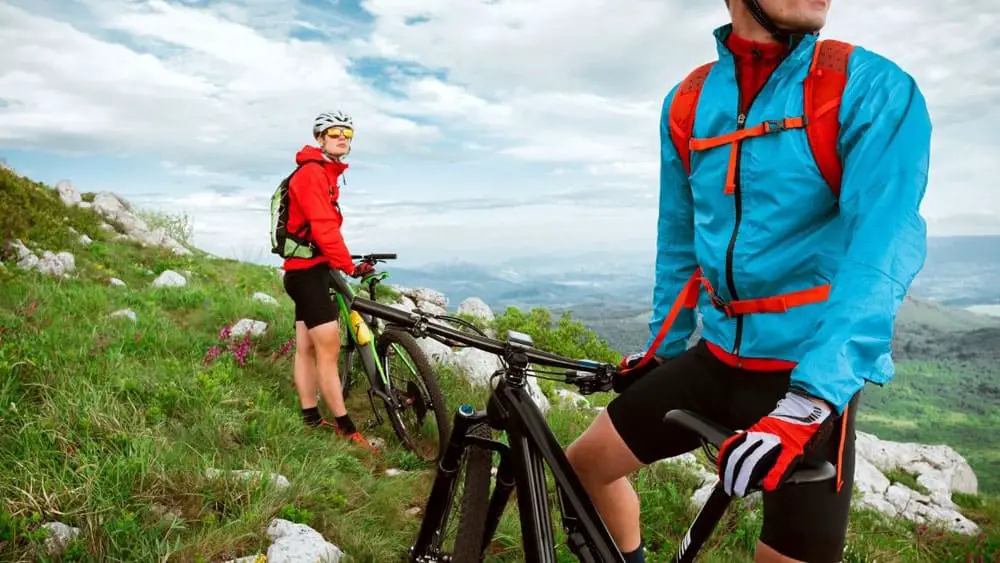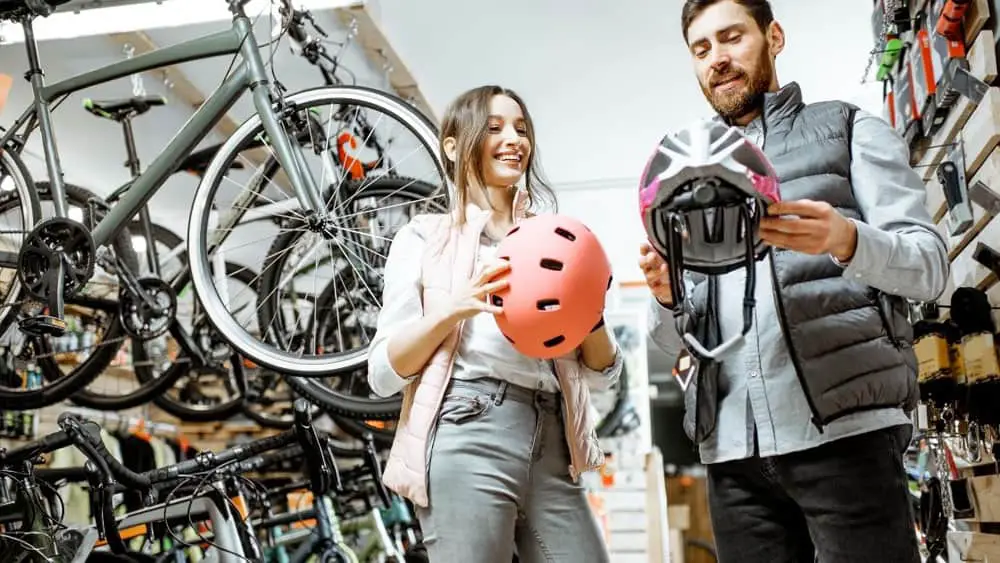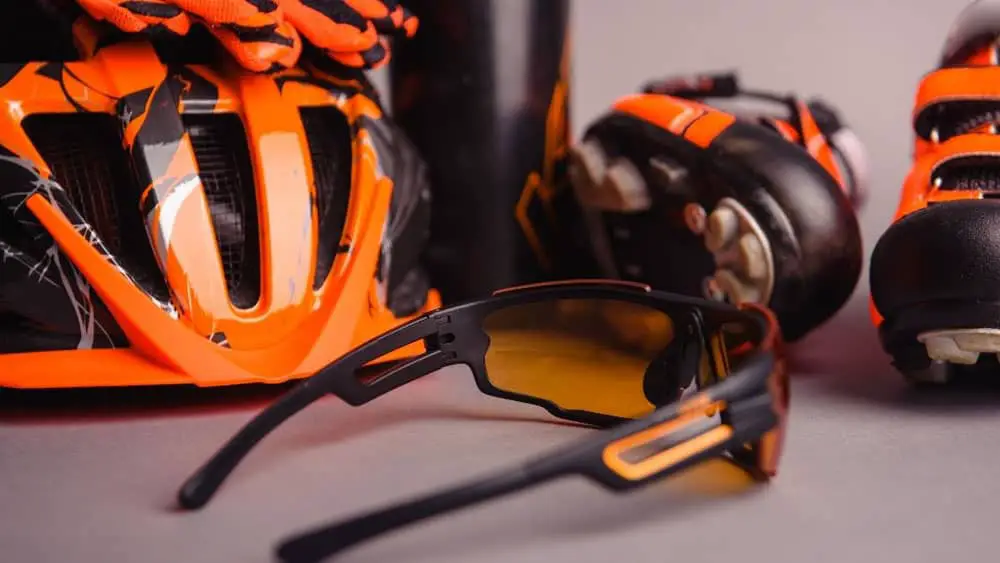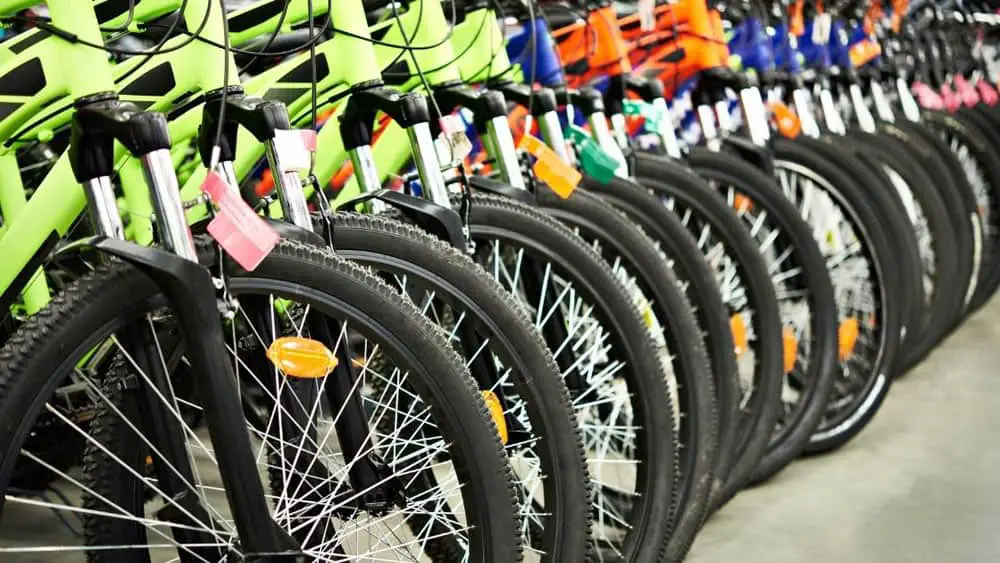
You are excited to saddle on your new mountain bike. Enticed by your outdoor “biker” friends, or want to try it out first to experience nature with your friends and family. Before going in “too deep” into the mountain biking sport, you must purchase a few essentials.
Well, before planning your first-ever mountain biking activity, here are a few things that are both essential and vital to have on hand so you are ready to take on the adventure, whatever the adventure may bring.
The Essentials
- Mountain Bike
- Helmet
Core Accessories
- Gloves
- Eye Protection
- Hydration Pack
- First-aid Kit
Proper Clothing
- Padded shorts
- Biking shoes and socks
- Shirt
- Rainwear
Repair Kit
- Spare inner tube
- Mini Pump
- Patch Kit
- Multi-Tool
- Duct tape
- Zip ties
Personal Items
- Food or snacks
- Medical information or Emergency contact card
- Mobile Phone
- Cash
- Hygiene
- Skin Protection such as Sunscreen, Lip-gloss, and Insect Repellent
Good to have
- Headlight and Taillight
- Whistle
- Lock
- Extra Clothing
- Power Bank
Assuming you already know your size and the mountain bike you want, I have listed the essential gears for mountain biking for beginners. Please take a moment to scan through the list and why they are a great deal of help on your first mountain bike ride.

THE ESSENTIALS
Let us begin with the obvious. You can’t go tear-up the trails without your trusted mountain bike and your high-quality helmet.
MOUNTAIN BIKE
Of course, the mountain bike is the essential equipment you need when deciding to do mountain biking as a sport. When buying a mountain bike, it is a no brainer that you need to know the types of mountain bikes.
There are two types of mountain bikes: full-suspension and hardtail. The difference between the two is that full-suspension bikes have suspension on the front and the rear, while the hardtail bikes only have suspension on the front. You can check my other blog post on Beginner’s Guide to Mountain Biking for a complete description of the two types.
Buying the right mountain bike takes research and patience. The more knowledge you have on mountain biking basic technical terms, the easier it will be to decide which bike best suits your needs.
I spent hours researching for my new mountain bike after looking at different bike styles and companies. I decided to go with a hardtail “Solitude” from Fezarri. You can go here to read more about why I chose to go with this company.
BIKE HELMET
The helmet is the next thing you MUST have after, of course, your bike. It is not hard to imagine getting a head-first after head-butting a rock or tree. So typically, I still choose the pay now rather than regret the latter route. Most cost money, but safety is priceless and well worth it. Disregard all others no matter how pretty or cool they might look.
At a minimum, choose a bike helmet that will provide not just comfort but most especially safety. Ensure the helmet has passed Federal Safety Standards with stickers showing the Consumer Product Safety Commission (CPSC) if you are in the United States. Or compliant with the Australian Standard (AS/NZS 2063) if in Australia.
An excerpt of Statistics from the American Journal of Surgery, 2016:
Helmeted bicycle riders had 51% reduced odds of severe Traumatic Brain Injury (TBI), and 44% reduced mortality rates. Helmet use also reduced the odds of facial fractures by 31%.
Conclusion: The bicycle helmet protects against severe TBI, reduces facial fractures, and saves lives even after sustaining an intracranial hemorrhage.
CORE ACCESSORIES
These mountain bike gear will be of use on your ride and provide the basic needs for you to survive even the shortest trip.
Cycling Gloves
Gloves, while not obvious at first, help not only for a comfortable grip to prevent hand blisters during long rides but also prevent scrapes since, if ever you crash, your hands are what you put out first. Remember that mountain biking is a lot more taxing on your hands than road cycling.
Mountain Biking Gloves typically offer a greater level of impact protection with more rigid materials and construction and external armoring in the form of molded plastic or carbon fiber panels.
In choosing between half or full-fingered gloves, I tend to go with the full-fingered. First, I felt them as restrictive. Eventually, I got friendly with them because you never only use your palms to break a fall. They may also utilize rigid materials like rubber on your palms, wrists, and fingers to keep you safe and should still be easy to move as for you to make biking hand signs.
Eyewear
Eyewear is something you might want to skip buying. Perhaps you are thinking how “cool” you are going to look. However, the importance of your shades goes beyond looks. This core gear will protect your only set of eyes from debris, unpredictable weather, and branches hitting your face.
Thinking about how the weather can change from bright and sunny to a full-blown rain with strong winds cannot be hard to imagine. Nature has lots of flying insects. The sun can hurt your eyes, and winds can bring dust and twigs.
There are many styles of eyewear with many different features and designs. The best sunglasses for mountain biking strike a delicate balance between protection, performance, and looks.
Choosing the lens tint will depend on where you will be riding. There are glasses with frames that support the interchangeable lens system that comes with various lenses for varying light conditions. Typically, we choose clear ones since it is not always bright in the mountain to see obstacles. Our favorite biking glasses are photochromic lenses. Engineered to vary tint depending on available light, making it easier to deal with rides with variable light conditions.
Hydration
Growing up, we all know that the human body is 60% water, and according to H.H. Mitchell, Journal of Biological Chemistry 158, the brain and heart are composed of 73% water, and the lungs are about 83% water. The skin contains 64% water, muscles, and kidneys are 79%. Imagine having inadequate water on all these significant organs can do to you.
The importance of staying hydrated during tiring activities is still highlighted. To help solve this during our biking, we employ a bottle of water caged to the bike frame or a Hydration Pack during rides more than 2 hours best have both the hydration pack and bottle to be sure. Having a hydration pack means you don’t have to stop, or even slow down, to take a sip of water; grab the drink tube that’s connected to the included water reservoir or bladder.
Hydration Backpacks are still the best for mountain biking not only because of how much water it can hold but also ideal for storing food, tools, and the like. Planning your ride is part of the choice, as you can also refill along the way if you do not want to carry the weight. There is also a surge of popularity on Hip Packs and Bum Bags at 4 liters up strapped to the hip and the hindquarters, respectively.
First-aid Kit
Talking about things that can always happen on the road, having a first-aid kit keeps your mind at ease, plus it is smart to carry. I always believe that it is better to have it and not need it than need it and not have it.
Abrasions are the most common injury mountain bikers suffer. Having first-aid kits in small amounts such as bandages, gauze, tape, pain relievers, alcohol, antiseptic, eye drops, tissues, tiny scissors, and your prescription medications are lifesavers. Treating an injury after it occurs will ensure that the problem doesn’t worsen before you can get home.

PROPER CLOTHING
Clothing for mountain biking is a different fashion that makes the wearer look prepared and tough and helps to keep you warm and provide protection and give you long-lasting comfort to get through your journey.
Padded shorts
Padded shorts or chamois will undoubtedly become your best friend because it can significantly make your long ride far more comfortable and enjoyable.
Chamois are padded in the short’s inner lining, almost like underwear, and reduces chafing due to the consistent rubbing of your skin on your bike. This extra cushioning gives a fair amount of protection around the crotch area.
On the other hand, Mountain Bike shorts are baggy shorts with extra pockets and a more relaxed look. They may or may not come with chamois. You can always buy a liner, which includes the padding. Choosing the right amount of thickness also plays a part as when the pads are too thick, it can also cause chafing.
Cycling Shoes
Cycling shoes are the ones that will provide comfort and control on your feet as you pedal. While you can wear just about any running shoes you have, cycling shoes have rigid soles and provide friction to keep your feet on to the pedals to have efficient energy transfer per pedal.
Mountain biking shoes should also be designed so that the shoes can protect your foot from debris and have the flexibility to achieve your full foot motion. Pair them with thick cycling socks to prevent any blisters.
Top Clothing
Top clothing can be anything from t-shirts, jerseys to tank tops. Grab what is comfortable and breathable for you if you have a polyester jersey though it would be a great idea to use since polyester jerseys have a moisture-wicking feature and save you money.
Moisture-wicking fabrics are perfect for activewear pieces because they help keep the body dry when you start to sweat from exercise or other types of exertion. A moisture-wicking fabric has two jobs: one is quickly moving (wicking) sweat to the fabric’s outer surface, and the other is drying rapidly so that your sweat doesn’t saturate the material.
Another thing to consider to invest in for your future rides are shirts that offer UPF protection, which stands for Ultraviolet Protection Factor. The number indicates what fraction of the sun’s ultraviolet rays can penetrate the fabric. A shirt with at least UPF of 30, The Skin Cancer Foundation Recommendation minimum in the US, allows just 1/30th, which means it blocks 96.7% of the sun’s UV radiation to reach your skin.
Rainwear
Rainwear helps us be less of a sloppy mess and keeps us warm when Mother Nature is moody, but there are many options to keep yourself and your valuables waterproof. Waterproof-breathable Jackets are the performance-cycling gold standard, keeping liquid water out while allowing water sweat to pass through. It is better to opt for a lightweight and packable jacket with a hood when selecting or buying your new rainwear.
REPAIR KIT
Repair kits usually come in small kits, but you can also prepare them from your tool section of the house since having them on hand is smart and assuring.
Patch Kit
One headache you will encounter more than once in your lifetime of mountain adventure is getting a flat tire caused by a small puncture. The easiest solution to get back on the dirt road is to use a patch kit to fix the tire.
Spare inner tube
Punctured tires might not be the only situation you will face on the trail if the damages are big enough that cannot be patched. Having a spare inner tube could mean that you can take out the wrecked tube and move on. Plus, these un-inflated inner tubes can be folded and stored or placed on your bike frame for light carrying.
Mini Pump
After fixing your tires with a Patch Kit or replacing the Inner Tube, you’ll need a way to inflate the tire. Always carry a small hand pump or CO2 inflator that will fit your backpack or mount to your bike frame.
Multi-Tool
A multi-tool or Swiss Knife can handle a surprisingly wide variety of repairs, and its versatility makes it a good value. Its small size means it fits easily in an on-bike saddle pack or a backpack. A good multi-tool has various allen wrenches, an adjustable wrench, or open or hex wrenches, a chain tool, Philips and flathead screwdriver, and sometimes a small Pliers.
Duct tape
When it is not the tires, and the new problem is hardware like our pedal, some duct tape can help keep that piece of the bike together. You do not need the entire roll of duct tape to carry. Just roll enough on an old card for light carrying.
Zip ties
Zip ties may surprise you why they were added to the repair kit but trust me; they are a lifesaver during those trying times. Zip-ties are a great option to temporarily fix your bike until you can get somewhere to fix the problem entirely. We’ve had seat droppers fail, brake line attachments snap, and all sorts of other things break, and these little guys did the job every time.

PERSONAL ITEMS
Items that may or may not be brought depending on how far out the biking trip would be. Planning is key.
Medical information or Emergency contact card
Before going out on a bike ride, be sure to let friends or family know where you plan to go. It is a good idea to carry with you medical and emergency contact information cards. They’re small, so you may as well bring them.
Food or snacks
Be sure to prepare a good array of food and beverage that will prevent exhaustion and provide you that energy to reach your destination.
Energy bars, bananas, apples, kiwi, and sandwiches (protein-rich sandwiches), whole wheat crackers, canned tuna, and trail mix will not just satisfy your hunger along the way. Still, they will boost your energy and give your body its much-needed vitamins and nutrients. Make sure also to grab a refreshing sports drink you enjoy on your next stop-over to replenish the lost electrolytes and vitamins.
Hygiene
Hygiene needs such as biodegradable waste bags, wet wipes or tissues, small soap, and travel toothbrushes with little toothpaste are essential during long rides. The important thing is we are relieved, and it is always lovely to be clean and healthy. Always remember, Take nothing but pictures, leave nothing but footprints.
Cash
Always keep a spare change as you may need to pay for any refill of refreshments and the like. It doesn’t hurt to have some cash when you need it.
Mobile Phone
Most of us will never forget this gadget, but I planned to keep it on the list to be sure. Your mobile phone can be a GPS tracker, camera, compass, map, flashlight, music, and entertainment, just to name a few of the useful functions. Be sure to charge full batteries before you head out.
Skin Protection such as Sunscreen, Lip-gloss, and Insect Repellent
Beginners must know and practice the 4Rs of long-distance cycling or mountain biking every hour: rehydrate, refuel, repeat, and reapply.
“More than 100,000 new cases of skin cancer are diagnosed annually in the UK. While the disease can also occur on parts of the body not exposed to sunlight, extensive sun exposure is thought to be responsible for the vast majority of cases,” says the British Association of Dermatologists. “In more than four out of five cases, skin cancer is a preventable disease.”
Apply sunscreen with at least SPF 30 before 20-30 minutes you ride, even when it’s not sunny, and reapply sunscreen at least every two hours.
GOOD TO HAVE
Items are optional, but it will always be a great idea if you have a spare area on your backpack.
Headlight and Taillight
Sometimes night time will fall without us noticing because of how enjoyable the ride is and it is better to have lights and reflectors to warn our neighbors on the road that we are present.
- Whistle
- Extra Clothing
- Power Bank
IN ESSENCE
Sometimes night time will fall without us noticing because of how enjoyable the ride is, and it is better to have lights and reflectors to warn our neighbors on the road that we are present.

